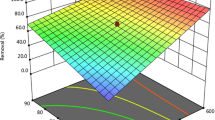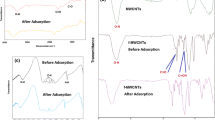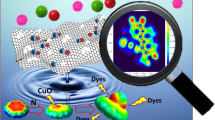Abstract
As well known, mercury is a toxic trace element due to its bioaccumulation and volatility which results in severe effects in health of ecosystems and humans’ life. Herein, for the first time, the synthesis of a N and S dual-doped waste-derived graphene-like nanoporous carbon via a facile and single-step route is presented and its capability in mercury vapor removal from gas streams is investigated. To prepare a modified adsorbent, thiourea was utilized as the doping agent to induce nitrogen and sulfur dopants into the nanoporous carbon structure derived from pyrolysis of cabbage (Capitat. var. Brassica oleracea) waste from Brassicaceae family as an inherently S, N-containing precursor, which is produced in noticeable amounts annually. The prepared adsorbents were characterized through FTIR, XRD, BET, SEM, TEM, and CHNOS techniques to get an insight into the structure, morphology, and chemical characteristics of the adsorbents. The structural characterization revealed the successful synthesis of a graphene-like nanoporous carbon sheet which was doped with nitrogen and sulfur atoms. The S, N dual-doped graphene-like carbon nanosheets showed an enhanced activity toward mercury vapor adsorption. For this end, two different dopant to carbon source ratios were considered and it was found that the higher dopant amount results in a better performance. From the adsorption experiments, it was revealed that the pristine graphene–like carbon had a less performance in mercury removal (71%) compared with doped samples (more than 90%) which shows the necessity of reinforcement and surface modification of as mentioned cabbage base graphene. However, the best sample which was prepared with the dopant to carbon ratio of 10 had a performance of 94.5% removal (2100 μg/g) compared with 89% (1980 μg/g) for mercury removal by the sulfur-impregnated commercial activated carbon.









Similar content being viewed by others
Data availability
Hereby, we confirm that all data and materials can be provided upon request by reviewers, editors, or readers.
References
Cao Y, Huang J, Li Y, Qiu S, Liu J, Khasanov A, Khan MA, Young DP, Peng F, Cao D (2016) One-pot melamine derived nitrogen doped magnetic carbon nanoadsorbents with enhanced chromium removal. Carbon 109:640–649
Chalkidis A, Jampaiah D, Hartley PG, Sabri YM, Bhargava SK (2020) Mercury in natural gas streams: a review of materials and processes for abatement and remediation. J Hazard Mater 382:121036
Couling DJ, Nguyen HV, Green WH (2012) Screening of metal oxides and metal sulfides as sorbents for elemental mercury at elevated temperatures. Fuel 97:783–795
Ding F, Zhao Y, Mi L, Li H, Li Y, Zhang J (2012) Removal of gas-phase elemental mercury in flue gas by inorganic chemically promoted natural mineral sorbents. Ind Eng Chem Res 51(7):3039–3047
Dong J, Xu Z, Kuznicki SM (2009) Mercury removal from flue gases by novel regenerable magnetic nanocomposite sorbents. Environ Sci Technol 43(9):3266–3271
Ghasemy E, Motejadded HB, Hamzehlouyan T, Yousefian Z (2018) N-doped CNT nanocatalyst prepared from camphor and urea for gas phase desulfurization: experimental and DFT study. J Taiwan Inst Chem Eng 85:121–131
Ghasemy E, Emrooz HBM, Rashidi A, Hamzehlouyan T (2020) Highly uniform molybdenum oxide loaded N-CNT as a remarkably active and selective nanocatalyst for H2S selective oxidation. Sci Total Environ 711:134819
Ghenaatian HR, Shakourian-Fard M, Kamath G (2019) The effect of sulfur and nitrogen/sulfur co-doping in graphene surface on the adsorption of toxic heavy metals (Cd, Hg, Pb). J Mater Sci 54(20):13175–13189
Hu C, Zhou J, He S, Luo Z, Cen K (2009) Effect of chemical activation of an activated carbon using zinc chloride on elemental mercury adsorption. Fuel Process Technol 90(6):812–817
Jurng J, Lee TG, Lee GW, Lee S-J, Kim BH, Seier J (2002) Mercury removal from incineration flue gas by organic and inorganic adsorbents. Chemosphere 47(9):907–913
Kabiri S, Tran DNH, Cole MA, Losic D (2016) Functionalized three-dimensional (3D) graphene composite for high efficiency removal of mercury. Environ Sci: Water Res Technol 2(2):390–402
Lazar P, Mach R, Otyepka M (2019) Spectroscopic fingerprints of graphitic, pyrrolic, pyridinic, and chemisorbed nitrogen in N-doped graphene. J Phys Chem C 123(16):10695–10702
Liu D, Li C, Wu J, Liu Y (2019) Novel carbon-based sorbents for elemental mercury removal from gas streams: a review. Chem Eng J 123514
Liu H, Chang L, Liu W, Xiong Z, Zhao Y, Zhang J (2020) Advances in mercury removal from coal-fired flue gas by mineral adsorbents. Chem Eng J 379:122263
Luo Z, Lim S, Tian Z, Shang J, Lai L, MacDonald B, Fu C, Shen Z, Yu T, Lin J (2011) Pyridinic N doped graphene: synthesis, electronic structure, and electrocatalytic property. J Mater Chem 21(22):8038–8044
Marczak M, Budzyń S, Szczurowski J, Kogut K, Burmistrz P (2019) Active methods of mercury removal from flue gases. Environ Sci Pollut Res 26(9):8383–8392
Meeprasert J, Junkaew A, Rungnim C, Kunaseth M, Kungwan N, Promarak V, Namuangruk S (2016) Capability of defective graphene-supported Pd13 and Ag13 particles for mercury adsorption. Appl Surf Sci 364:166–175
Naushad M, Ahamad T, Al-Maswari BM, Alqadami AA, Alshehri SM (2017) Nickel ferrite bearing nitrogen-doped mesoporous carbon as efficient adsorbent for the removal of highly toxic metal ion from aqueous medium. Chem Eng J 330:1351–1360
Seema H, Kemp KC, Le NH, Park S-W, Chandra V, Lee JW, Kim KS (2014) Highly selective CO2 capture by S-doped microporous carbon materials. Carbon 66:320–326
Simões EF, Leitão JM, da Silva JCE (2017) Sulfur and nitrogen co-doped carbon dots sensors for nitric oxide fluorescence quantification. Anal Chim Acta 960:117–122
Sun D, Ban R, Zhang P-H, Wu G-H, Zhang J-R, Zhu J-J (2013) Hair fiber as a precursor for synthesizing of sulfur-and nitrogen-co-doped carbon dots with tunable luminescence properties. Carbon 64:424–434
Sun H, Zhao S, Ma Y, Wu J, Liang P, Yang D, Zhang H (2018) Effective and regenerable Ag/4A zeolite nanocomposite for Hg0 removal from natural gas. J Alloys Compd 762:520–527
Suresh Kumar Reddy K, Al Shoaibi A, Srinivasakannan C (2014) Elemental mercury adsorption on sulfur-impregnated porous carbon–a review. Environ Technol 35(1):18–26
Vidic RD, Siler DP (2001) Vapor-phase elemental mercury adsorption by activated carbon impregnated with chloride and chelating agents. Carbon 39(1):3–14
Wdowin M, Wiatros-Motyka MM, Panek R, Stevens LA, Franus W, Snape CE (2014) Experimental study of mercury removal from exhaust gases. Fuel 128:451–457
Wdowin M, Macherzyński M, Panek R, Górecki J, Franus W, Christidis G (2015) Investigation of the sorption of mercury vapour from exhaust gas by an Ag-X zeolite. Clay Miner 50(1):31–40
Wu H, Jiang J, Gu X, Tong C (2017) Nitrogen and sulfur co-doped carbon quantum dots for highly selective and sensitive fluorescent detection of Fe (III) ions and L-cysteine. Microchim Acta 184(7):2291–2298
Xie J, Qu Z, Yan N, Yang S, Chen W, Hu L, Huang W, Liu P (2013) Novel regenerable sorbent based on Zr–Mn binary metal oxides for flue gas mercury retention and recovery. J Hazard Mater 261:206–213
Xie J, Xu H, Qu Z, Huang W, Chen W, Ma Y, Zhao S, Liu P, Yan N (2014) Sn–Mn binary metal oxides as non-carbon sorbent for mercury removal in a wide-temperature window. J Colloid Interface Sci 428:121–127
Xu H, Qu Z, Zhao S, Mei J, Quan F, Yan N (2015a) Different crystal-forms of one-dimensional MnO2 nanomaterials for the catalytic oxidation and adsorption of elemental mercury. J Hazard Mater 299:86–93
Xu Q, Pu P, Zhao J, Dong C, Gao C, Chen Y, Chen J, Liu Y, Zhou H (2015b) Preparation of highly photoluminescent sulfur-doped carbon dots for Fe (III) detection. J Mater Chem A 3(2):542–546
Xu Y, Zhong Q, Liu X (2015c) Elemental mercury oxidation and adsorption on magnesite powder modified by Mn at low temperature. J Hazard Mater 283:252–259
Yao Y, Velpari V, Economy J (2014) Design of sulfur treated activated carbon fibers for gas phase elemental mercury removal. Fuel 116:560–565
Yu Z, Bai Y, Wang Y, Liu Y, Zhao Y, Liu Y, Sun K (2017) One-step synthesis of three-dimensional nitrogen and sulfur co-doped graphene networks as low cost metal-free counter electrodes for dye-sensitized solar cells. Chem Eng J 311:302–309
Yuan X, An N, Zhu Z, Sun H, Zheng J, Jia M, Lu C, Zhang W, Liu N (2018) Hierarchically porous nitrogen-doped carbon materials as efficient adsorbents for removal of heavy metal ions. Process Saf Environ Prot 119:320–329
Yun YS, Le V-D, Kim H, Chang S-J, Baek SJ, Park S, Kim BH, Kim Y-H, Kang K, Jin H-J (2014) Effects of sulfur doping on graphene-based nanosheets for use as anode materials in lithium-ion batteries. J Power Sources 262:79–85
Zeng X, Xu Y, Zhang B, Luo G, Sun P, Zou R, Yao H (2017) Elemental mercury adsorption and regeneration performance of sorbents FeMnOx enhanced via non-thermal plasma. Chem Eng J 309:503–512
Zhang J, Duan Y, Zhou Q, Zhu C, She M, Ding W (2016a) Adsorptive removal of gas-phase mercury by oxygen non-thermal plasma modified activated carbon. Chem Eng J 294:281–289
Zhang J, Yang Z, Qiu J, Lee H-W (2016b) Design and synthesis of nitrogen and sulfur co-doped porous carbon via two-dimensional interlayer confinement for a high-performance anode material for lithium-ion batteries. J Mater Chem A 4(16):5802–5809
Zhang G, Wang P, Lu W-T, Wang C-Y, Li Y-K, Ding C, Gu J, Zheng X-S, Cao F-F (2017) Co nanoparticles/Co, N, S tri-doped graphene templated from in-situ-formed Co, S co-doped g-C3N4 as an active bifunctional electrocatalyst for overall water splitting. ACS Appl Mater Interfaces 9(34):28566–28576
Zhou Q, Duan Y-F, Hong Y-G, Zhu C, She M, Zhang J, Wei H-Q (2015) Experimental and kinetic studies of gas-phase mercury adsorption by raw and bromine modified activated carbon. Fuel Process Technol 134:325–332
Zhou Z, Liu X, Li C, Cao XE, Xu M (2020) Seawater-assisted synthesis of MnCe/zeolite-13X for removing elemental mercury from coal-fired flue gas. Fuel 262:116605
Author information
Authors and Affiliations
Contributions
Forouzan Vakili: investigation, data curation, writing—original draft preparation. Alimorad Rashidi: supervision, conceptualization, methodology, validation, writing—reviewing and editing; Lobat Taghavi: advisor, validation, writing—reviewing. Nabiollah Mansouri: advisor, validation, writing—reviewing.
Corresponding author
Ethics declarations
Conflict of interest
The authors declare that there is no conflict of interest.
Ethical approval
Hereby, we confirm that we consent to all ethical standards of the journal.
Consent to participate
Hereby, we confirm that the presented research work does not include any data regarding the humans’ health or any investigation on humans or animals.
Consent to publish
Hereby, we confirm that we consent to publish the work according to the guidelines of the journal.
Additional information
Responsible Editor: Tito Roberto Cadaval Jr
Publisher’s note
Springer Nature remains neutral with regard to jurisdictional claims in published maps and institutional affiliations.
Rights and permissions
About this article
Cite this article
Vakili, F., Rashidi, A., Taghavi, L. et al. Single-step synthesis of N, S co-doped waste-derived nanoporous carbon sorbent for mercury vapor removal. Environ Sci Pollut Res 28, 17265–17274 (2021). https://doi.org/10.1007/s11356-020-12075-2
Received:
Accepted:
Published:
Issue Date:
DOI: https://doi.org/10.1007/s11356-020-12075-2




